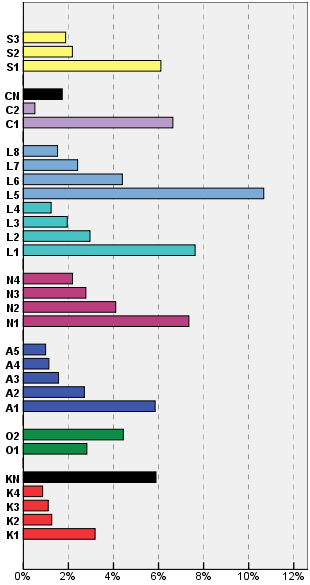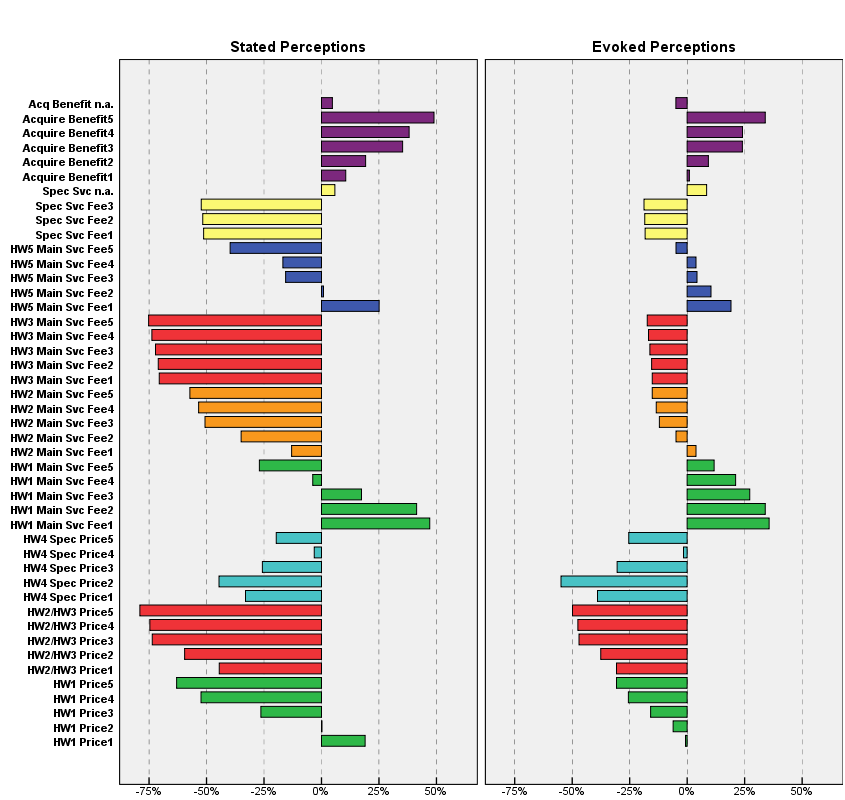 > CSDCA
- Common Scale Discrete Choice Analysis > CSDCA Examples
> CSDCA
- Common Scale Discrete Choice Analysis > CSDCA Examples
This example is taken from the already cited technical paper where the detailed results from a comparative experiment fielded on an internet panel in December 2012 are presented. The object of the study was intention to purchase a HDTV set. The tested profiles were described by 8 attributes with 25 aspects in total. Approximately 1200 respondents divided into 4 cells, each answering a different questionnaire, completed the study.
The paper is full of important results that an interested reader might appreciate. One of them seems to support the view that omitting the third CHOICES section may not be critical. In the reported case the multiple correlation coefficient between the two versions was 0.99. Below is a picture of rescaled aggregate scores of common-scale part-worths (influences in our terminology) obtained from fusion of all three sections (PRIORS, MOTIVATORS and CHOICES) in the questionnaire.

Comparisons not available from any other format of conjoint study are
possible. E.g., the attribute "Superior contrast rating" (score of 6) is
twice as likely to be picked as an attribute that makes respondents want
to buy an HDTV compared to "2 year warranty" (score of 3). Score of "Wired
& WiFi internet" overcomes 3 brands of the 6 brands tested. Having the
scores all placed on a common ratio scale makes it very easy to interpret
the results. The common pitfalls, namely lack of ability to compare
utilities between attributes and lack of ratio scale that often bedevil
inexperienced end-users of conjoint analysis are avoided.

The simplest implementation of CSDCA is a single MOTIVATORS section as is the case of a study of selectable options for a range of telecommunication tariffs. The project was carried out by g82 s.r.o. in 2014.
The aspects were grouped into seven attributes. Aspects in each attribute were essentially the same option with different prices except attribute L that was composed of two (color-coded) alternatives with different prices. As the aspects in attributes had natural order of attractiveness the PRIORS section was omitted. Prices are rising from the bottom up in the picture on the right.
Results are presented as relative influences of the aspects giving 100% influence in total. No attempt to estimate price thresholds was made in this case. Attributes C and O had only two price levels, so the search for their price thresholds would be meaningless.
Options represented by attributes C and K were supposed to have generally low acceptability, and have been supplemented with the levels CN and KN stating "option is not offered. The initial assumption was confirmed for attribute K, but was not manifested for attribute C. Interest at the price level C1 was nearly 4-times higher than that for a situation when this option was shown as "not offered".

The most common implementation of CSDCA is expected to be a combination of the two main DCM sections, PRIORS and MOTIVATORS. The example is taken from a project carried out by g82 s.r.o. in 2014.
The tested product was a telecommunication tariff with aspects grouped into four attributes. Individual aspects were composed of several features (benefits and/or services) including prices. The prices compensated for the features included in the aspects. The aspect acceptances had therefore no natural order.
Each attribute was extended by a level "None (I would not accept any of them)" for obtaining acceptability thresholds in the section PRIORS. The obtained threshold values are shown in black and given index levels N in the picture right.
 As aside
As aside
All four attributes, but without the extension level "None" were shown in the section MOTIVATORS.
Attribute T, composed of the basic characteristics of tariffs (monthly fee, call rates, SMS rates and FUP data limit), was clearly of the greatest influence. Dominating were the first 4 aspects with influences above a threshold value. The other aspects integrated in the tariffs evoked much lower interest, perhaps except aspect D4 with acceptability at a threshold level, i.e. possibly acceptable for about 50% of the tested population sample.
Similarity in the threshold values for all the four attributes is worth of noting. There is a consistency of respondents' subjective acceptance-refusal threshold values for all four attributes in the process of sequential choices in section PRIORS.
"The trouble with market research is that people don't think how they feel,
they don't say what they think and they don't do what they say."
[ David Ogilvy ]
The differences in the views mentioned in the motto can be, up to a point, unmasked by comparing perceptions of isolated feature (attribute) levels, and perceptions of the same levels in profiles of complete products, where the features are considered jointly. The acceptability of features in full profiles can be determined by calibration of profile utilities obtained from CSDCA, and be compared with acceptability of the same feature levels obtained from asking about the isolated features one by one.
 As aside
As aside
The device was tested in 5 package configurations HW1 to HW5, differing technically and in the ways to be offered. Each package had 2 compound attributes specific to a package and 3 attributes common to all packages. The questionnaire had 4 main sections. These were (1) determination of thresholds for ordinal attributes (mostly prices), (2) ranks and thresholds for nominal attributes (both in the PRIORS section), (3) the choice-based MOTIVATORS section, (4) a short rank-based conjoint and a calibration based on 8 fully specified products (designed by the client). The interview took about 12 min. As a standard, the results from a study of the kind are [relative] influence of attribute levels on willingness to purchase, estimation of market potential and preference-share based simulation. In this study, an additional goal was to distinguish between "stated" perceptions of attribute levels presented in isolation, and "evoked" perceptions of attribute levels considered jointly, i.e. in presence of the other attributes and several other products.
It is presumed that the stated perceptions based on statements and thresholds from the PRIORS section and scaled by the answers in the MOTIVATORS sections relate to "what people say". In contrast, evoked perceptions are based on the choices in CHOICES section (typically a CBC) and the statements in calibration sections, and are supposed to relate to "what people [would] do". The neutral (zero) stated perceptions are related to the indecisive purchase intention statements (the third one in a symmetrical 5-point Liker scale). The results for 45 levels are in the picture below. We omit results for another 19 levels for the sake of discretion.


The main trait in the results above is a substantially decreased intensity of nearly all evoked perceptions. The most marked sensitivity decrease is observed for the main service fee associated with the products HW2 and HW3.
The absence of an acquirement benefit inquired in isolation was not explicitly stated as negative. However, when an acquirement benefit was offered in other competing products in the calibration section, the absence of an acquirement benefit appeared as negative.
The acceptance threshold for the main service fee associated with the product HW5 has shifted to a higher price. The same is true for the products HW2 and HW3, but less markedly. On the other hand, the up-front price threshold associated with product HW1 decreased. A probable reason for these observations is the well known conjunction of up-front prices (usually more influential) and installments-like service fees (usually less influential). For the same reason, the negative evoked perceptions of up-front prices of the product HW4 were even higher than their stated perceptions.
The influences on willingness to purchase for the same attribute levels are shown at the right. While perceptions reflect the levels "within isolated attributes", be it stated or evoked ones, influences reflect the leverage of the same levels in the complete product, i.e. "between product attributes" as obtained from the calibration exercise. Clearly, perceptions do not predict the influence on purchase intentions correctly. In too many cases, levels with enough positive influences have negative perceptions.
 As aside
As aside
The results confirm that perceptions of levels of isolated attributes are, in general, different from their evoked perceptions when considered jointly in a product. The influences show yet another picture of the results. Clearly, the actual product attributes settings and product promotional communication should grow out of different foundations.